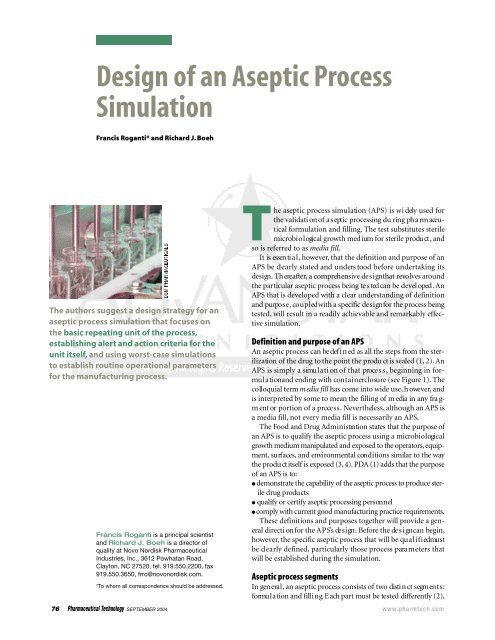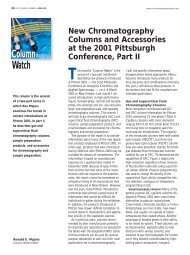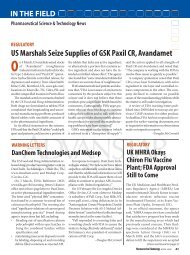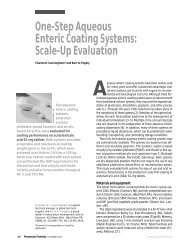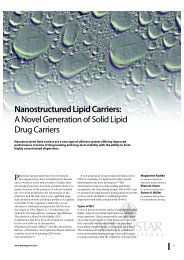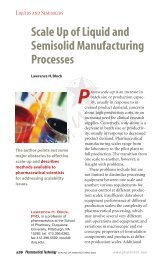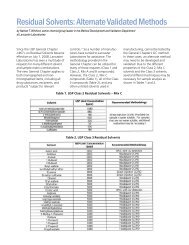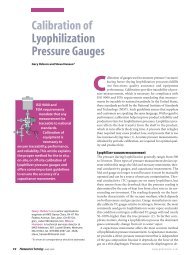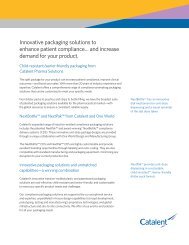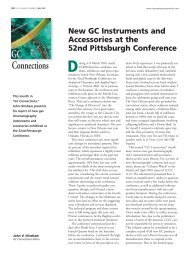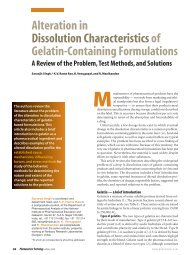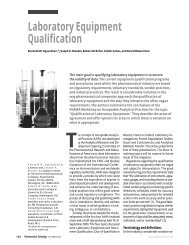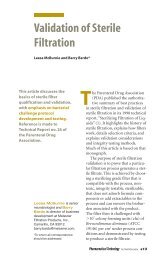Design of an Aseptic Process Simulation - Pharmaceutical Technology
Design of an Aseptic Process Simulation - Pharmaceutical Technology
Design of an Aseptic Process Simulation - Pharmaceutical Technology
You also want an ePaper? Increase the reach of your titles
YUMPU automatically turns print PDFs into web optimized ePapers that Google loves.
<strong>Design</strong> <strong>of</strong> <strong>an</strong> <strong>Aseptic</strong> <strong>Process</strong><br />
<strong>Simulation</strong><br />
Fr<strong>an</strong>cis Rog<strong>an</strong>ti* <strong>an</strong>d Richard J. Boeh<br />
The authors suggest a design strategy for <strong>an</strong><br />
aseptic process simulation that focuses on<br />
the basic repeating unit <strong>of</strong> the process,<br />
establishing alert <strong>an</strong>d action criteria for the<br />
unit itself, <strong>an</strong>d using worst-case simulations<br />
to establish routine operational parameters<br />
for the m<strong>an</strong>ufacturing process.<br />
Fr<strong>an</strong>cis Rog<strong>an</strong>ti is a principal scientist<br />
<strong>an</strong>d Richard J. Boeh is a director <strong>of</strong><br />
quality at Novo Nordisk <strong>Pharmaceutical</strong><br />
Industries, Inc., 3612 Powhat<strong>an</strong> Road,<br />
Clayton, NC 27520, tel. 919.550.2200, fax<br />
919.550.3650, frro@novonordisk.com.<br />
*To whom all correspondence should be addressed.<br />
The aseptic process simu l a ti on (APS) is wi dely used for<br />
the va l i d a ti on <strong>of</strong> a s eptic processing du ring ph a rm aceutical<br />
formulation <strong>an</strong>d filling. The test substitutes sterile<br />
m i c robi o l ogical growth med ium for sterile produ ct , a n d<br />
so is referred to as media fill.<br />
It is essen ti a l , h owever, that the def i n i ti on <strong>an</strong>d purpose <strong>of</strong> a n<br />
APS be cl e a rly stated <strong>an</strong>d unders tood before undertaking its<br />
de s i gn . Th ere a f ter, a com preh en s ive de s i gn that revo lves aro u n d<br />
the particular aseptic process being te s ted c<strong>an</strong> be devel oped . An<br />
APS that is developed with a clear underst<strong>an</strong>ding <strong>of</strong> definition<br />
<strong>an</strong>d purpo s e , co u p l ed with a specific de s i gn for the process bei n g<br />
tested, will result in a readily achievable <strong>an</strong>d remarkably effective<br />
simulation.<br />
Definition <strong>an</strong>d purpose <strong>of</strong> <strong>an</strong> APS<br />
An aseptic process c<strong>an</strong> be def i n ed as all the steps from the steri<br />
l i z a ti on <strong>of</strong> the drug to the point the produ ct is sealed (1, 2 ) . An<br />
APS is simply a simu l a ti on <strong>of</strong> that proce s s , beginning in formu<br />
l a ti on <strong>an</strong>d ending with con t a i n er cl o su re (see Figure 1). Th e<br />
co ll oquial term m edia fill has come into wi de use, h owever, a n d<br />
is interpreted by some to me<strong>an</strong> the filling <strong>of</strong> m edia in <strong>an</strong>y fra g-<br />
m ent or porti on <strong>of</strong> a proce s s . Nevert h el e s s , a l t h o u gh <strong>an</strong> APS is<br />
a media fill, not every media fill is necessarily <strong>an</strong> APS.<br />
The Food <strong>an</strong>d Drug Ad m i n i s tra ti on states that the purpose <strong>of</strong><br />
<strong>an</strong> APS is to qualify the aseptic process using a microbi o l ogi c a l<br />
growth med ium m<strong>an</strong>ipulated <strong>an</strong>d ex po s ed to the opera tors , equ i p-<br />
m en t , su rf ace s , <strong>an</strong>d envi ron m ental con d i ti ons similar to the way<br />
the produ ct itsel f is ex po s ed (3, 4 ) . P DA (1) adds that the purpo s e<br />
<strong>of</strong> <strong>an</strong> APS is to :<br />
● dem on s tra te the capabi l i ty <strong>of</strong> the aseptic process to produ ce sterile<br />
drug produ ct s<br />
● qualify or certify aseptic processing pers on n el<br />
● com p ly with current good m<strong>an</strong>u f actu ring practi ce requ i rem en t s .<br />
These definitions <strong>an</strong>d purposes together will provide a general<br />
directi on for the A P S’s de s i gn . Before the de s i gn c<strong>an</strong> begi n ,<br />
h owever, the specific aseptic process that wi ll be qu a l i f i ed mu s t<br />
be cl e a rly def i n ed , p a rti c u l a rly those process para m eters that<br />
will be established during the simulation.<br />
<strong>Aseptic</strong> process segments<br />
In gen era l , <strong>an</strong> aseptic process consists <strong>of</strong> t wo disti n ct segm en t s :<br />
formu l a ti on <strong>an</strong>d fill i n g.E ach part must be te s ted differen t ly (2),<br />
76 <strong>Pharmaceutical</strong> <strong>Technology</strong> SEPTEMBER 2004 w w w. p h a rm t e c h . c o m
Table I: Typical APS variable or worst-case parameters with rationale <strong>an</strong>d best-case settings to be used for normal<br />
o p e r a t i o n s .<br />
Formulation segment<br />
APS setting (worst case) Rationale for APS setting Operational setting (best case)<br />
Sterile bulk media to be held Qualify a sterile shelf life longer th<strong>an</strong> Sterile bulk product to be held no<br />
for 7 days required for production more th<strong>an</strong> 5 days<br />
Increase number <strong>of</strong> formulation Maximize intrusive sampling into Limit formulation sampling<br />
samplings<br />
sterile bulk<br />
Increase environmental monitoring Increase intrusion into the Environmental monitoring returned<br />
during aseptic connection room during aseptic connection to routine during normal formulations<br />
Filling segment<br />
APS setting (worst case) Rationale for APS setting Operational setting (best case)<br />
Perform APS following completion APS is performed with room, Return to routine equipment<br />
<strong>of</strong> a production fill, with minimal equipment, <strong>an</strong>d environmental ch<strong>an</strong>ge <strong>an</strong>d s<strong>an</strong>itization process<br />
equipment ch<strong>an</strong>ge <strong>an</strong>d no post- conditions at less th<strong>an</strong><br />
production s<strong>an</strong>itization<br />
optimal conditions<br />
Number <strong>of</strong> personnel in the t<strong>an</strong>k Increase overall viable <strong>an</strong>d Number <strong>of</strong> personnel in the t<strong>an</strong>k<br />
room <strong>an</strong>d fill room >5 during APS nonviable particulates room <strong>an</strong>d fill room
Table II: Upper 95% confidence limit for a Poisson<br />
variable with <strong>an</strong> equation for calculating contamination<br />
rate (5, 6).<br />
Observed media-fill<br />
failure frequency Upper 95%<br />
(integral, intact units)<br />
confidence limit<br />
0 2.9957<br />
1 4.7439<br />
2 6.2958<br />
3 7.7537<br />
4 9.1537<br />
5 10.5130<br />
6 11.8424<br />
7 13.1481<br />
Contamination rate is upper 95% confidence limit X 100/number <strong>of</strong><br />
media-filled units.<br />
Calculation to derive 6300 units:<br />
0.0475% 5 (2.9957 3 100)/number <strong>of</strong> media-filled units<br />
wi ll be em bed ded within the day shift, <strong>an</strong>d repe a ted again for<br />
the night shift. In i tial qu a l i f i c a ti on wi ll requ i re three con s ecutive<br />
two-shift simu l a ti on s ; t h ere a f ter requ a l i f i c a ti onwi ll require<br />
at least one two-shift simulation twice per year (1–3).<br />
When we reflect on the concept <strong>of</strong> segments <strong>an</strong>d basic units<br />
<strong>an</strong> APS de s i gn , we recogn i ze that the con cept is essen ti a lly no<br />
more th<strong>an</strong> a reflection <strong>of</strong> the batch records. The entire aseptic<br />
process may alre ady be segm en ted into formu l a ti on or fill i n g<br />
b a tch record s , <strong>an</strong>d the filling batch record may be furt h er divi<br />
ded into units recording shift ch a n ge s , pers on n el pre s ent in<br />
the fill room , i n terven ti ons <strong>an</strong>d stopp a ges (including their duration),<br />
the pulling <strong>of</strong> samples representative <strong>of</strong> the shifts, <strong>an</strong>d<br />
the envi ron m ental mon i toring revo lving around the shifts. O n ce<br />
the de s i gn <strong>of</strong> the APS has captu red the aseptic process to this<br />
ex ten t , <strong>an</strong>d has def i n ed the basic unit rel a tive to the proce s s ,<br />
then all that remains is to determine how to test the unit effectively,<br />
what parameters within the unit to vary, <strong>an</strong>d the accept<strong>an</strong>ce<br />
criterion for that unit. The APS must focus on the basic<br />
filling unit when determining the level <strong>of</strong> process control, <strong>an</strong>d<br />
u l ti m a tely the overa ll accept a bi l i ty <strong>of</strong> the filling segm ent <strong>of</strong> t h e<br />
aseptic process.<br />
<strong>Aseptic</strong> process parameters.In the design <strong>of</strong> <strong>an</strong> APS, a distincti<br />
on must be made bet ween those parts <strong>of</strong> the aseptic proce s s<br />
that are to remain fixed , <strong>an</strong>d those that are to be va ri ed . It is<br />
these va ri a ble com pon ents <strong>of</strong> the process that are ad ju s ted in<br />
w ays to pre s ent a worst case situ a ti on from wh i ch fixed ro uti n e<br />
m a nu f actu ring para m eters are establ i s h ed . Ma nu f actu ring wo u l d<br />
t h en be limited to opera ti ons within the establ i s h ed APS param<br />
eters , t h ereby providing the highest degree <strong>of</strong> process contro<br />
l . The directi on <strong>of</strong> the ad ju s tm ent for each va ri ed para m e-<br />
ter, h owever, must be eva lu a ted caref u lly (e . g . , f i lling speed or<br />
opera tor fatigue) to en su re that a true worst case is pre s en ted<br />
du ring the simu l a ti on . Some examples <strong>of</strong> worst case situ a ti on s ,<br />
or variable parameters are as follows:<br />
● s i mu l a te envi ron m ental <strong>an</strong>d equ i pm en t / com pon ent fati g u e<br />
associated with the longest permitted run on the processing<br />
line (2, 4)<br />
Table III: Two-shift APS accept<strong>an</strong>ce criteria using alert<br />
<strong>an</strong>d action limits based on a minimum <strong>of</strong> 6300 integral,<br />
intact media-filled units/shift versus a combined minimum<br />
<strong>of</strong> 12,600 units/two shifts.<br />
Each shift Both shifts<br />
6300 units 12,600 units<br />
Alert limit (,0.05% contamination ,1 2<br />
rate at 95% confidence level)<br />
Action limit (,0.1% contamination 1 6<br />
rate at 95% confidence level)<br />
● increase bioburden <strong>of</strong> the environment (1, 4)<br />
● set filling speed at the worst case operational r<strong>an</strong>ge (1, 2, 4)<br />
● increase number <strong>of</strong> interventions (4)<br />
● increase frequency <strong>of</strong> environmental sampling<br />
● simulate operator fatigue (4)<br />
● i n c rease the time peri od bet ween the com p l eti on <strong>of</strong> equ i p-<br />
m en t / com pon ent steri l i z a ti on <strong>an</strong>d the start <strong>of</strong> the proce s s<br />
simulation (1, 2)<br />
● increase the number <strong>of</strong> breaks or shift ch<strong>an</strong>ges (1, 2, 4).<br />
Aga i n , these va ri a ble para m eters are set at worse case for the<br />
process simulation, <strong>an</strong>d then set at best case for routine m<strong>an</strong>u<br />
f actu ri n g. Th o u gh some <strong>of</strong> these worst case situ a ti ons may be<br />
u n ivers a l , it is import<strong>an</strong>t that there be a com p l ete <strong>an</strong>d independent<br />
determination <strong>of</strong> variable parameters that are applica<br />
ble for a specific aseptic process to en su re that all app l i c a bl e<br />
va ri a bles are inclu ded in the simu l a ti on’s de s i gn . The def a u l t<br />
use <strong>of</strong> universal parameters in the design <strong>of</strong> <strong>an</strong> APS, without a<br />
com p l ete determ i n a ti on for the other app l i c a ble para m eters ,<br />
may result in a flawed simulation: it may lack sufficient or app<br />
l i c a ble worst case situ a ti ons for a given proce s s , l e aving the<br />
test’s overall effectiveness in question.<br />
APS batch record <strong>an</strong>d protocol<br />
The de s i gn <strong>of</strong> the APS begins with the de s i gn <strong>of</strong> the simu l a ti on<br />
batch record, which should be written in the same format as a<br />
normal batch record <strong>an</strong>d contain all <strong>of</strong> the normal data: sign<strong>of</strong>f<br />
elements; typical <strong>an</strong>d atypical interventions; <strong>an</strong>d all the inform<br />
a ti on , a t t ach m en t s , <strong>an</strong>d doc u m en t a ti on that norm a lly<br />
would be attach ed to a batch record (1, 2 ) . The APS pro toco l<br />
should be de s i gn ed to give clear directi ons for the simu l a ti on<br />
batch record by providing at least the following:<br />
● i den ti f i c a ti on <strong>of</strong> the process being simu l a ted (formu l a ti on or<br />
filling segment or both) down to its basic filling unit (in this<br />
case, the two shifts) (1, 2)<br />
● i den ti f i c a ti on <strong>of</strong> the room , equ i pm en t , f i lling line, bu l k - h o l d<br />
t a n k , con t a i n er <strong>an</strong>d cl o su re , <strong>an</strong>d microbi o l ogical growt h<br />
m ed ium to be used , <strong>an</strong>d vo lume <strong>of</strong> m ed ium per con t a i n er to<br />
be filled (1, 2)<br />
● i den ti f i c a ti on <strong>of</strong> i n c u b a tors , i n c u b a ti on ti m e , <strong>an</strong>d tem peratu<br />
res for all samples, toget h er with growth prom o ti on requirements<br />
for the microbiological medium (1, 2)<br />
● nu m ber <strong>of</strong> i n tegra l , i n t act units to be fill ed for each shift, ensuring<br />
that the number is large enough to: (a) include all requ<br />
i red m<strong>an</strong>ipulati on s , i n terven ti on s , <strong>an</strong>d sampling, <strong>an</strong>d (b)<br />
effectively determine the contamination rate (1, 2)<br />
80 <strong>Pharmaceutical</strong> <strong>Technology</strong> SEPTEMBER 2004 w w w. p h a rm t e c h . c o m
Figure 1: Typical aseptic process. The drug product is formulated <strong>an</strong>d then filtersterilized<br />
into a bulk-hold t<strong>an</strong>k, glass containers depyrogentated, <strong>an</strong>d closures<br />
autoclaved or irradiated. Then all segments are brought together in a Class 100 fill<br />
room. During <strong>an</strong> APS, the drug product is substituted with a microbiological growth<br />
medium.<br />
● nu m ber <strong>an</strong>d du ra ti on <strong>of</strong> i n terven ti ons or stopp a ge s , i n d i c a t-<br />
ing the minimum total number <strong>an</strong>d minimum duration for<br />
each (1, 2)<br />
● clear documentation <strong>of</strong> APS particip<strong>an</strong>ts <strong>an</strong>d their activity<br />
● a detailed list <strong>of</strong> the variable parameters to be adjusted, giving<br />
their set ti n gs for worst case, the ra ti onale for these setti<br />
n gs (1, 2 ) , <strong>an</strong>d the best case set ti n gs that wi ll be used for normal<br />
processes (see Table I)<br />
● reconciliation <strong>an</strong>d accountability <strong>of</strong> bulk media <strong>an</strong>d mediafilled<br />
units<br />
● accept a n ce cri teria for all tests perform ed (1, 2 ) , i n cluding the<br />
acceptable contamination rate for each filling unit or shift.<br />
APS contamination rate<br />
For the filling segm ent <strong>of</strong> the A P S , a full stati s tical approach for<br />
assessing the prob a ble con t a m i n a ti on ra te is ava i l a bl e . Th e<br />
method not only provides more confidence in establishing the<br />
accept a ble con t a m i n a ti on ra te , but also defines the use <strong>of</strong> a l ert<br />
limits (5, 6).<br />
The use <strong>of</strong> <strong>an</strong> alert limit in the accept a n ce cri teria c<strong>an</strong> provi<br />
de a me<strong>an</strong>s for determining the minimum nu m ber <strong>of</strong> u n i t s<br />
to be fill ed du ring the A P S , <strong>an</strong>d for ad ju s ting <strong>an</strong> aseptic m<strong>an</strong>u -<br />
facturing process toward a no-failure rate in a process simulati<br />
on . For ex a m p l e , with <strong>an</strong> acti on limit set at the recogn i zed<br />
con t a m i n a ti on ra te <strong>of</strong> ,0.1% at the 95% con f i den ce level , a n<br />
alert limit could be set below this at 0.0475% at the<br />
95% con f i den ce level . From Ta ble II, we c<strong>an</strong> calculate<br />
that a minimum <strong>of</strong> 6300 units must be filled to<br />
detect a po s i tive at this alert limit. Fu rt h er sti p u l a-<br />
ti ons within the pro tocol then would state that exceeding<br />
the alert limit would requ i re a revi ew <strong>of</strong> t h o s e<br />
ad ju s t a ble va ri a ble para m eters <strong>an</strong>d m<strong>an</strong>u f actu ri n g<br />
practi ces to determine if ad ju s tm ents c<strong>an</strong> be made<br />
to prevent exceeding the alert limit.<br />
An example <strong>of</strong> the criteria that would be set for a<br />
shift sch edu l ed to fill a minimum <strong>of</strong> 6300 units is<br />
s h own in Ta ble III. These same cri teria would be app<br />
l i ed to each shift in a two-shift simu l a ti on , wh ere<br />
each shift is scheduled to fill 6300 units for <strong>an</strong> overall<br />
two-shift total <strong>of</strong> 12,600 units. In this scenario, if<br />
e ach shift produ ced one po s i tive unit, t h en each shift<br />
must exceed the alert limit, but not the action limit.<br />
On the other h<strong>an</strong>d, if one shift produced both posi<br />
tive s , it must exceed the acti on limit while the remaining<br />
shift would have exceeded no limit.<br />
Consider for a moment the alert <strong>an</strong>d action limits<br />
app l i ed to a com bi n ed two-shift simu l a ti on ins<br />
te ad <strong>of</strong> e ach shift. The total nu m ber <strong>of</strong> f i ll ed units<br />
requ i red at the end <strong>of</strong> the two-shift simu l a ti on wo u l d<br />
be set at a minimum <strong>of</strong> 12,600, with each shift contri<br />
buting approx i m a tely half <strong>of</strong> t h e s e . Aga i n , u s i n g<br />
Ta ble II to calculate the nu m ber <strong>of</strong> con t a m i n a ted<br />
units exceeding each limit, we find that each shift<br />
could produ ce two po s i tives for a com bi n ed two -<br />
shift total <strong>of</strong> four po s i tive units, wh i ch would exceed<br />
the alert limit, but not the acti on limit (see Ta ble III).<br />
Using the approach <strong>of</strong> accessing each shift independen<br />
t ly, h owever, would re sult in a failed simu l a ti on , because eit<br />
h er shift producing two po s i tives would have been iden ti f i ed<br />
as exceeding the action limit (see Table III).<br />
Summary <strong>of</strong> APS design strategy<br />
The pivotal points in the A P S’s de s i gn are its focus on the basic<br />
repeating unit; the m<strong>an</strong>ipulation <strong>of</strong> numbers, time, <strong>an</strong>d speed<br />
to increase ch a ll en ge to the microbi o l ogical growth med iu m ;<br />
<strong>an</strong>d the ef fective app l i c a ti on <strong>of</strong> <strong>an</strong> accept a ble con t a m i n a ti on<br />
rate for each shift within the basic unit.<br />
Wh en app l i ed to <strong>an</strong> aseptic process in wh i ch the basic fill i n g<br />
unit consists <strong>of</strong> t wo shifts, a simu l a ti on exercise should be comp<br />
l eted in the first shift, <strong>an</strong>d then repe a ted in the second shift,<br />
with the cri teri on for con t a m i n a ti on ra te establ i s h ed at the shift<br />
l evel <strong>an</strong>d not at the basic filling unit level . To do otherwise co u l d<br />
mask a dys f u n cti onal shift, giving the impre s s i on that the overall<br />
two-shift process is acceptable.<br />
Cri tical to the simu l a ti on de s i gn is the iden ti f i c a ti on <strong>of</strong> a ll<br />
process para m eters to be va ri ed <strong>an</strong>d the ad ju s tm ent <strong>of</strong> t h e s e<br />
p a ra m eters to pre s ent a worst-case situ a ti on du ring the proce s s<br />
s i mu l a ti on . E s s en ti a lly, the para m eters are ad ju s ted tow a rd mic<br />
robi a lly ch a ll en ging <strong>an</strong> otherwise sterile microbi o l ogical growt h<br />
medium, <strong>an</strong>d then adjusted in reverse to present a safer situation<br />
during normal aseptic processing to ensure reproducibility<br />
<strong>of</strong> the process control achieved during the simulation.<br />
82 <strong>Pharmaceutical</strong> <strong>Technology</strong> SEPTEMBER 2004 w w w. p h a rm t e c h . c o m
F i n a lly, the simu l a ti on de s i gn must incorpora<br />
te a cred i ble accept a n ce cri teri on<br />
for the con t a m i n a ti on ra te . Mu ch disc<br />
u s s i on exists in this are a , pri m a ri ly abo ut<br />
h ow m<strong>an</strong>y failed units, i f a ny, a re acceptable<br />
in establishing a reasonable level <strong>of</strong><br />
process con tro l , a l t h o u gh m<strong>an</strong>y agree that<br />
a no-failu re ra te should be ach i eva ble for<br />
a process that produces a sterile product<br />
( 1 , 2 , 4 ) . A well - de s i gn ed aseptic proce s s ,<br />
h owever, should have little difficulty in approaching<br />
a no-failure rate during simulation,<br />
<strong>an</strong>d when coupled with a well-des<br />
i gn ed A P S , the simu l a ti on wi ll leave little<br />
doubt as to the degree <strong>of</strong> process control<br />
being achieved.<br />
References<br />
1. P DA Technical Report #22, “ <strong>Process</strong> Si mul<br />
a ti on Te s ting for As epti c a lly Fill ed Produ ct s ,”<br />
PDA J. Pharm. Sci. Technol. 50 (SI), 1996.<br />
2. PDA Technical Report # 28, “<strong>Process</strong> Simul<br />
a ti on Te s ting for As epti c a lly Fill ed Produ ct s ,”<br />
PDA J. Pharm. Sci. Technol. 52 (5), 1998.<br />
3. F DA , “Gu i deline on Sterile Drug Produ ct s<br />
Produ ced by As eptic Proce s s i n g,” ( F DA ,<br />
Rockville, MD, 1987).<br />
4. F DA , “S terile Drug Produ cts Produ ced by<br />
<strong>Aseptic</strong> <strong>Process</strong>ing Draft,” (FDA, Center for<br />
D ru gs Eva lu a ti on <strong>an</strong>d Re s e a rch , Rock vi ll e ,<br />
MD, 2002).<br />
5. Health Ca n ad a , Th era peutic Produ cts Progra<br />
m m e , “ <strong>Process</strong> Va l i d a ti on : As eptic Proce s s e s<br />
for Pharm aceuti c a l s ,” ( Health Ca n ad a , Ott<br />
aw a , Ca n ad a , 2 0 0 1 ) .<br />
6. ISO 13408-1, “As eptic <strong>Process</strong>ing <strong>of</strong> He a l t h<br />
Ca re Produ ct s – Pa rt 1:Gen eral Requ i rem en t s ,”<br />
(ISO, Geneva Switzerl<strong>an</strong>d, 1998). P T<br />
Please rate this article.<br />
On the Reader Service Card, circle a number:<br />
345 Very useful <strong>an</strong>d informative<br />
346 Somewhat useful <strong>an</strong>d informative<br />
347 Not useful or informative<br />
Your feedback is import<strong>an</strong>t to us.<br />
F Y I<br />
New Drug Deve l o p m e nt <strong>an</strong>d De l i ve ry Ce nte r<br />
Researchers at the Georgia Institute <strong>of</strong> <strong>Technology</strong><br />
(Atl<strong>an</strong>ta,GA, www.gatech.edu) have launched the<br />
Center for Drug <strong>Design</strong>, Development, <strong>an</strong>d Delivery.<br />
By integrating the work <strong>of</strong> more th<strong>an</strong> 20 faculty<br />
members from 6 fields, the center is expected to<br />
focus Georgia Tech’s interdisciplinary efforts on<br />
bringing new drugs to market.<br />
Research areas will center on developing new<br />
chemical, biological, <strong>an</strong>d physical me<strong>an</strong>s for<br />
delivering drugs into the body. Chemical<br />
technologies will include encapsulation, a delivery<br />
method that uses microscopic polymer particles to<br />
protect drugs or genes from degradation in the<br />
body.The technique provides extended release over<br />
time.<br />
Researchers also will be using modified viruses to<br />
deliver genes that c<strong>an</strong> treat c<strong>an</strong>cer without<br />
inducing immune reactions or other problems.<br />
Finally, the center will host a research project that<br />
uses physical me<strong>an</strong>s—including electric fields <strong>an</strong>d<br />
arrays <strong>of</strong> microscopic needles—to painlessly<br />
deliver therapeutic genes,proteins, <strong>an</strong>d drugs<br />
through the skin.<br />
In addition to these projects, the center will<br />
create educational projects <strong>an</strong>d industry<br />
collaborations to give undergraduate <strong>an</strong>d graduate<br />
students a broad underst<strong>an</strong>ding <strong>of</strong> the<br />
pharmaceutical industry. With funding from the US<br />
Department <strong>of</strong> Education, the center has already<br />
launched a program <strong>of</strong> doctoral fellowships to<br />
support 12 students.<br />
84 <strong>Pharmaceutical</strong> <strong>Technology</strong> SEPTEMBER 2004 w w w. p h a r m t e ch . c o m


